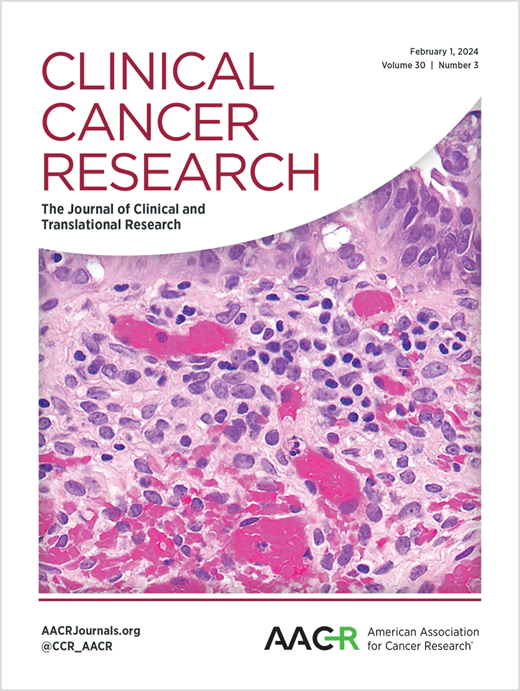利用trail诱导的细胞死亡和FLT3L免疫调节的工程同种异体干细胞介导的抗肿瘤免疫
IF 10
1区 医学
Q1 ONCOLOGY
引用次数: 0
摘要
目的:死亡受体(DR)靶向治疗为高度恶性脑肿瘤,如胶质母细胞瘤(GBM)提供了一种有希望的肿瘤细胞特异性治疗策略。然而,dr介导的细胞死亡是否导致适应性免疫系统的激活并影响肿瘤免疫微环境(TIME)尚不清楚。本研究探讨了1)可分泌的人DR4/5配体、肿瘤坏死因子(TNF)相关凋亡诱导配体(S-TRAIL)的免疫调节作用;2)异体干细胞(SCs)传递S-TRAIL和髓系祖细胞活化细胞因子,fms样酪氨酸激酶3配体(FLT3L)的治疗潜力。实验设计:我们建立了表达人鼠嵌合DR5的同源小鼠免疫活性和免疫抑制小鼠GBM肿瘤模型。接下来,我们创建了释放FLT3L和S-TRAIL的治疗性SCs,并评估了它们在GBM肿瘤模型中的疗效。为了便于临床翻译,我们测试了SC-TRAIL/FLT3L包封在gbm切除的同基因和人源化小鼠肿瘤模型中基于机制的疗效。结果:我们发现S-TRAIL诱导的GBM细胞凋亡在体内时间内刺激树突状细胞(DC)的浸润和成熟。接下来,我们发现gbm切除术后局部移植包封的双峰SCs提高了生存率,并诱导了常规DC1型(cDC1)和CD8+ T细胞的上调。此外,在携带gbm的人源化小鼠中,用包封的现成临床级双峰人SCs治疗可显著减少肿瘤体积。结论:本研究揭示了trail介导的细胞死亡在TIME中的免疫学作用,为包膜细胞治疗杀死残留肿瘤细胞和诱导长期免疫提供了依据。本文章由计算机程序翻译,如有差异,请以英文原文为准。
Anti-tumor immunity mediated by engineered allogeneic stem cells exploiting TRAIL-induced cell death and FLT3L immunomodulation
Purpose: Death receptor (DR)-targeted therapies offer a promising tumor cell-specific therapeutic strategy for highly malignant brain tumors, such as glioblastoma (GBM). However, whether DR-mediated cell death leads to activation of the adaptive immune system and impacts the tumor immune microenvironment (TIME) remains unknown. In this study we explored the 1) immunomodulatory role of secretable human DR4/5 ligand, tumor necrosis factor (TNF)-related apoptosis-inducing ligand (S-TRAIL); and 2) the therapeutic potential of allogeneic stem cells (SCs) delivered S-TRAIL and myeloid progenitor cell activating cytokine, FMS-like tyrosine kinase 3 ligand (FLT3L). Experimental Design: We created syngeneic murine immune -active and -suppressive mouse GBM tumor models expressing a human-murine chimeric DR5. Next, we created therapeutic SCs that release FLT3L and S-TRAIL and assessed their efficacy in GBM tumor models. To facilitate clinical translation, we tested the mechanism-based efficacy of encapsulated SC-TRAIL/FLT3L in both syngeneic and humanized mouse tumor-models of GBM-resection. Results: We show that S-TRAIL induced apoptosis in GBM cells provokes infiltration and maturation of dendritic cells (DC) within the TIME in vivo. Next, we show that local transplantation of encapsulated bimodal SCs post-surgical GBM-resection improves the survival probability and induces upregulation of conventional DC type 1 (cDC1) and CD8+ T cells. Furthermore, treatment with encapsulated off-the-shelf clinical-grade bimodal human SCs in GBM-bearing humanized mice results in a significant decrease in tumor-volumes. Conclusions: This study uncovers the immunological role of TRAIL-mediated cell death in the TIME and provides evidence for the encapsulated cell-based therapy to kill residual tumor-cells and induce long-term immunity.
求助全文
通过发布文献求助,成功后即可免费获取论文全文。
去求助
来源期刊

Clinical Cancer Research
医学-肿瘤学
CiteScore
20.10
自引率
1.70%
发文量
1207
审稿时长
2.1 months
期刊介绍:
Clinical Cancer Research is a journal focusing on groundbreaking research in cancer, specifically in the areas where the laboratory and the clinic intersect. Our primary interest lies in clinical trials that investigate novel treatments, accompanied by research on pharmacology, molecular alterations, and biomarkers that can predict response or resistance to these treatments. Furthermore, we prioritize laboratory and animal studies that explore new drugs and targeted agents with the potential to advance to clinical trials. We also encourage research on targetable mechanisms of cancer development, progression, and metastasis.
 求助内容:
求助内容: 应助结果提醒方式:
应助结果提醒方式:


